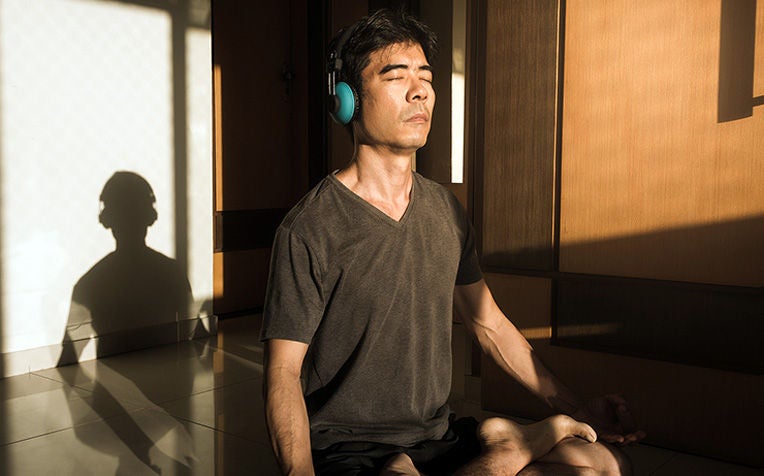
The 'dropping anchor' meditation exercise, when practiced frequently, can help you to effectively manage difficult thoughts, feelings, emotions, memories, urges and sensations.
Information and video provided courtesy of the Government of Western Australia - Centre for Clinical Interventions (CCI).
What is the 'dropping anchor' meditation?
Dropping anchor is a very useful skill. You can use it for handling difficult thoughts, feelings, emotions, memories, urges and sensations more effectively; switching off auto-pilot and engaging in life; grounding and steadying yourself in difficult situations; disrupting rumination, obsessing and worrying; focusing your attention on the task or activity you are doing; developing more self-control; and as a ‘circuit-breaker’ for impulsive, compulsive, aggressive, addictive or other problematic behaviours.
How to do the 'dropping anchor' meditation exercise
'Dropping anchor' involves playing around with a simple formula: ACE
A: Acknowledge your thoughts and feelings
C: Come back into your body
E: Engage in what you’re doing
A: Acknowledge your thoughts and feelings
Silently and kindly acknowledge whatever is ‘showing up’ inside you: thoughts, feelings, emotions, memories, sensation, urges. Take the stance of a curious scientist, observing what’s going on in your inner world.
And while continuing to acknowledge your thoughts and feelings, also…
C: Come back into your body
Come back into and connect with your physical body. Find your own way of doing this. You could try some or all of the following, or find your own methods:
Slowly pushing your feet hard into the floor
Slowly straightening up your back and spine; if sitting, sitting upright and forward in your chair
Slowly pressing your fingertips together
Slowly stretching your arms or neck, shrugging your shoulders.
Slowly breathing
Note: you are not trying to turn away from, escape, avoid or distract yourself from what is happening in your inner world. The aim is to remain aware of your thoughts and feelings, continue to acknowledge their presence and at the same time, come back into and connect with your body. In other words, you are expanding your focus: aware of your thoughts and feelings, and also aware of your body while actively moving it.
And while acknowledging your thoughts and feelings, and connecting with your body, also…
E: Engage in what you’re doing
Get a sense of where you are and refocus your attention on the activity you are doing. Find your own way of doing this. You could try some or all of the following suggestions, or find your own methods:
Look around the room and notice 5 things you can see
Notice 3 or 4 things you can hear.
Notice what you can smell or taste or sense in your nose and mouth
Notice what you are doing
End the exercise by giving your full attention to the task or activity at hand. Ideally, run through the ACE cycle slowly 3 or 4 times, to turn it into a 2-3 minute exercise.
NOTE: Please don’t skip the A of ACE; it’s so important to keep acknowledging the thoughts and feelings present, especially if they are difficult or uncomfortable. If you skip the A, this exercise will turn into a distraction technique – which it’s not supposed to be.
How does the 'dropping anchor' meditation help?
There are many possible purposes for practicing this skill. Most of them are listed in the first paragraph above, but in addition, this skill is often used as a first step in handling flashbacks, panic attacks, chronic pain, and many other issues. So, if you are not sure why your counselor or health practitioner has recommended you to practice this, and how it can help you with your issue, please ask them to clarify the aim of it.
Adjust the exercise duration to suit your needs
If you are pushed for time, just do a 30 second version: run through the ACE cycle once If you’re up for a challenge, run through the ACE cycle extremely slowly, over and over, for 5 to 10 minutes. There are literally hundreds of ways to modify this exercise, to accommodate your needs (e.g. physical pain) or overcome any difficulties you may have with it. Please ask your counselor or health practitioner how to do so.
Practice the 'dropping anchor' meditation exercise often
Also remember, you can practise these kinds of exercises, any time, any place, any activity. And it’s a good idea to practise them often in less challenging situations, when your thoughts and feelings are less difficult, so you can build up your skill levels. Over time, the idea is to use this in more challenging situations, when your thoughts and feelings are more difficult.
Get audio recordings of the 'dropping anchor' exercise
If you wish, you can download free audio recordings of ‘dropping anchor’ exercises, varying from 1 minute to 11 minutes in length. You can listen to these and use them as a guide to help you develop this skill. You can download or stream them from: https://www.actmindfully.com.au/free-stuff/free-audio/
Hear an audio recording of the 'dropping anchor' meditation exercise.
Ref: K21


















 Get it on Google Play
Get it on Google Play